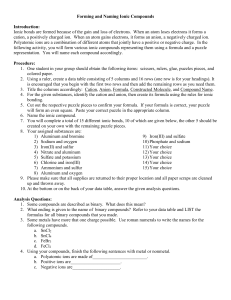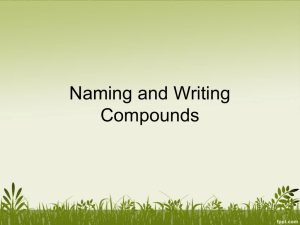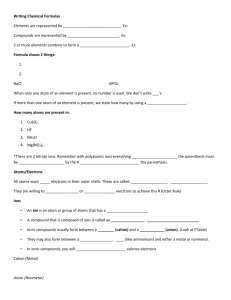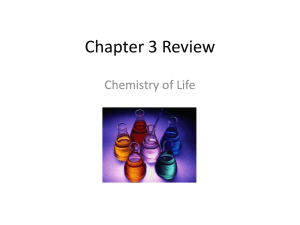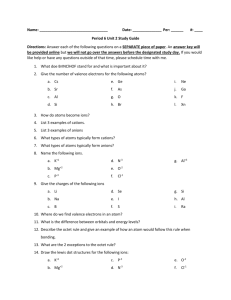Chapter 6
advertisement
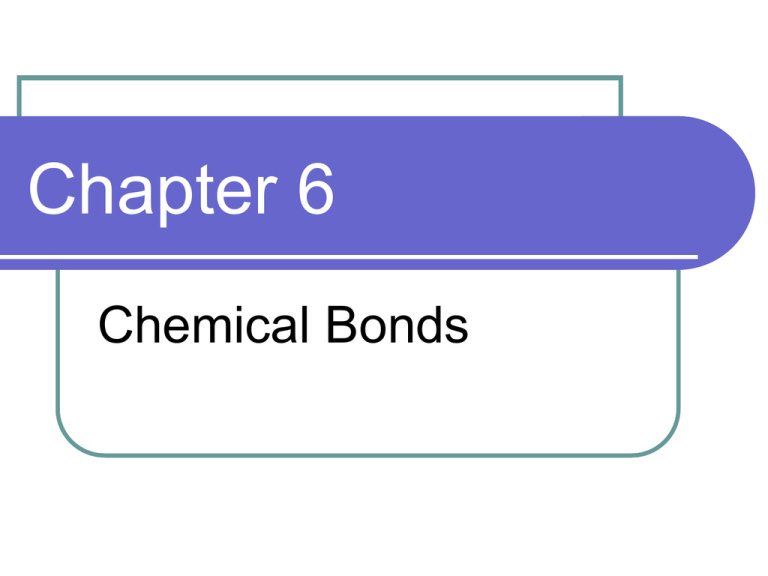
Chapter 6 Chemical Bonds Show second one http://science.howstuffworks.com/periodictable-videos-playlist.htm Ionic Bonds Sec. 6.1 When elements react they tend to transfer electrons to become stable Ex. Na and Cl When ions form the charge changes from neutral because of a change in the number of protons or electrons. Ex. Na+ and Cl- 1 2 Lose e- 3 4 5 6 Gain/ Gain eLose e- 7 Anion Negative charge Have the ending –ide Ex. Cl becomes chloride Cation Positive charge The name is the same as the element + Ex. Na is sodium Ionic Compounds Shows the ratio of the atoms in the compound Ex. NaCl Ex. MgCl2 (2 Cl atoms needed) Properties of Ionic Compounds Strong attraction of ions High melting point Not malleable Ionic Compounds The name of the compound must distinguish it from other compounds of the same elements The formula describes the ratio of the elements that make up the compound Naming Binary Compounds They follow a predictable pattern of the cation followed by the anion Remember: the anion will end in –ide Ex. Figure 16 Common Anions Practice with compounds Write the chemical formulas for the following compounds using their valence electrons to assist you… Li and N K and P H and F Al and P C and S Al and Br C and Sn B and N Rb and Se Answers Li3N K3 P HF Al3P3(AlP) C2S4(CS2) AlBr3 C4Sn4 (CSn) B3N3 (BN) Rb2Se Naming the compounds from previous slide Li and N K and P H and F Al and P C and S Al and Br C and Sn Ba and C Rb and Se Lithium nitride Potassium phosphide Hydrogen fluoride Aluminum phosphide Carbon sulfide Carbon Tinide Aluminum Bromide Boron Nitride Rubidium selenide Multiple Ions The transition metals form more than one type of ion Ex. Cu (I) with a 1+ charge and Cu (II) with a 2+ charge The other elements have positive charges that are equal to their group number Polyatomic Ions Many ions Positive or negatively charged Figure 19 Writing Formulas for Ionic Compounds Determine the ratio of elements needed in the compound by using the charges given. Ex. Na has a 1+ charge and S has a 2- charge = Na2S Practice Page 174 Covalent Bonding 6.2 Sharing electrons (Co) means to share Ex. Hydrogen Single bond between the elements H-H H2 describes a molecule of Hydrogen Many nonmetals exist as diatomic molecules Ex. Cl2 Multiple Covalent Bonding Sharing multiple pairs of electrons Ex. N2 has a triple bond Page 167 Polar or Nonpolar Molecule? If it has only two atoms, it is polar If there are more than two atoms, the type of atoms and the shape determine whether the molecule is polar or nonpolar H2O is polar because it has a bent shape Polar attractions are greater than nonpolar Naming Molecular Compounds 6.3 The most metallic element appears first in the name The name of the second will end in – ide Ex. N2O4 – dinitrogen tetraoxide NO2 – nitrogen dioxide Prefixes for naming compounds is figure 20 Metallic Bonds 6.4 Metals become cations with a pool of shared electrons surrounding it The attraction between the cation and the surrounding electrons is the metallic bond Properties of Metal The ability to conduct and malleability are two properties of metal that are explained by the structure of the electrons around the metal Figure 22 - malleability Alloys Mixture of metals Copper – when mixed with tin will produce bronze, and when mixed with zinc will produce brass Steel – a mixture of iron and small amounts of carbon



